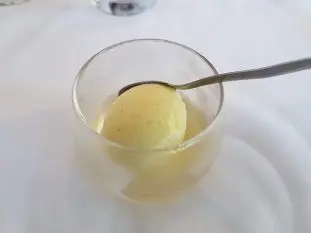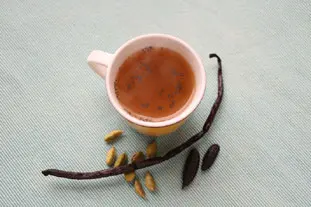This site uses only a few technical cookies necessary for its operation. By continuing to browse, you accept their use.
To find out more...
To find out more...
The return of the "Norman hole"

You maybe know the "trou normand", this old gastronomic custom typically French which consists in taking a (small) glass of calvados, generally between the last course and the dessert?
It's something that seems a bit anachronistic nowadays, having a glass of an alcohol of more than 60° in the middle of a meal, often with wines, to supposedly "ease digestion", ouch!
It's something that seems a bit anachronistic nowadays, having a glass of an alcohol of more than 60° in the middle of a meal, often with wines, to supposedly "ease digestion", ouch!
15 K 4.8/5 (13 reviews)
Keywords for this post:MealCustomNormandyNormandCalvadosSorbetLast modified on: December 18th 2021
The return of the "Norman hole"
If the original practice is rather debatable (personally, I'm almost sure that I won't see the dessert, or else in a fog :-), the principle on the other hand is not stupid: In a rather rich meal, like a holiday meal, take a little break before the dessert, and why not, by tasting something different.
It is a little bit towards that that the usage has been adapted for several decades, we always practice the Norman hole, but it is rather with something fresh, like a sorbet, often alcoholic, we do not completely remake.
The great classic, always in the Norman spirit, is a small dish with an apple sorbet, without or with a dash of calvados poured over it just before serving, or its "colonel" version with lemon and vodka sorbet.
The freshness of the sorbet, welcome at the end of the meal, is typical of what great restaurants call the pre-dessert.
In the end, it is a certain contrast that is sought, we have just eaten the main course, often quite substantial, perhaps washed down with strong wines, our mouths are a little full, a touch of lightness, of freshness, would be welcome.
Someone who is a bit strict might tell you to stop fussing, and simply drink a glass of fresh water, that it would be enough, and he would probably be right, but it is a holiday meal, we want to get out of the ordinary.
But instead of limiting yourself to the two initial options, alcohol alone (classic but outdated) or sorbet/ice (more modern but overused), it is also possible to think outside the box and go for something more daring, here are some ideas for, perhaps, your upcoming holiday meals.
- You don't serve anything with it, no little cookies or sweets, that would be too much.
- We serve the guests, and we sit with them right away, it is also a moment of exchange, the preparation of the dessert can wait a little.
- Or something fresh like a small iced coffee, a fruit mousse, a very light cream, a red fruit chantilly, or even a small fresh fruit salad.
- More daring, it could be something hot: a sabayon, vanilla or with a hint of citrus, served in a tiny cup.
- Last hot/tidy idea: mulled apple juice (my favourite), or hot cider.
In all of this, you should find something that will pass the "trou normand" test with flying colors with your guests, and who knows, maybe even surprise them a bit.
In summary:The "trou normand" in its principle, a refreshing break in a meal, is a good idea that can be declined in many ways, not necessarily alcoholic.
It is a little bit towards that that the usage has been adapted for several decades, we always practice the Norman hole, but it is rather with something fresh, like a sorbet, often alcoholic, we do not completely remake.
The great classic, always in the Norman spirit, is a small dish with an apple sorbet, without or with a dash of calvados poured over it just before serving, or its "colonel" version with lemon and vodka sorbet.
The freshness of the sorbet, welcome at the end of the meal, is typical of what great restaurants call the pre-dessert.

In the end, it is a certain contrast that is sought, we have just eaten the main course, often quite substantial, perhaps washed down with strong wines, our mouths are a little full, a touch of lightness, of freshness, would be welcome.
Someone who is a bit strict might tell you to stop fussing, and simply drink a glass of fresh water, that it would be enough, and he would probably be right, but it is a holiday meal, we want to get out of the ordinary.
But instead of limiting yourself to the two initial options, alcohol alone (classic but outdated) or sorbet/ice (more modern but overused), it is also possible to think outside the box and go for something more daring, here are some ideas for, perhaps, your upcoming holiday meals.
A few rules that can't be ignored
- We stick to something small, a ramekin for example is too big, you need a very small glass, or a cup, or an espresso/ristretto cup.- You don't serve anything with it, no little cookies or sweets, that would be too much.
- We serve the guests, and we sit with them right away, it is also a moment of exchange, the preparation of the dessert can wait a little.
And some suggestions
-It can be something very cold, a fruit sorbet with a little acidity for example: apple already mentioned, citrus fruits (clementine for example) or red fruits.- Or something fresh like a small iced coffee, a fruit mousse, a very light cream, a red fruit chantilly, or even a small fresh fruit salad.
- More daring, it could be something hot: a sabayon, vanilla or with a hint of citrus, served in a tiny cup.
- Last hot/tidy idea: mulled apple juice (my favourite), or hot cider.

In all of this, you should find something that will pass the "trou normand" test with flying colors with your guests, and who knows, maybe even surprise them a bit.
In summary:The "trou normand" in its principle, a refreshing break in a meal, is a good idea that can be declined in many ways, not necessarily alcoholic.
Lasts posts
Butter vs. grease
We often read in a recipe where a pastry is put into a mould that, just before pouring, the mould should be buttered or greased. But what's the difference between these 2 terms?December 1st 20251,3475
Getting out of the fridge early
Very often when you're cooking, you need to take food or preparations out of the fridge, to use them in the recipe in progress. There's nothing tricky about this: you just take them out of the fridge and use them, usually immediately, in the recipe. But is this really a good method?November 24th 20251,2605
Who's making the croissants?
When you look at a bakery from the outside, you naturally think that in the bakery, the bakers make the bread, and in the laboratory, the pastry chefs make the cakes. It's very often like that, with each of these professions having quite different ways of working, but sometimes there's also one...November 23th 20251,141
Oven height
When we put a dish or cake in the oven, we naturally tend to put it on the middle shelf, and that's what we usually do. But in some cases, this position and height can be a little tricky, so let's find out why.October 8th 20253,1665
The importance of sieving
In recipes that use a fine powder (flour, powdered sugar, etc.), you'll often see the advice to sift before using it. To sift is to pass the powder in question through a sieve (a very fine strainer) before incorporating it into your recipe. It's often advice, but is it really useful?September 3rd 20257,8243
Other pages you may also like
What is the difference between bakery and patisserie?
This is a question that you may well have asked yourself and which I will attempt to answer. In France the two trades of "boulangerie" (bakery) and "pâtisserie" (patisserie and confectionery) have always been quite distinct, but where exactly do the boundaries lie? .February 7th 2017134 K 14.1
The golden-brown finish on puff pastry
Let's take a look at the tricky matter of producing puff pastry with an attractive, golden-brown finish. French pastry chefs call this "dorure" (literally, "gilding"). Behind this quirky term there lurks a real problem (and the solution): when using puff pastry (pâte feuilletée) for a pie, or...February 8th 201848 K 24.6
How to sprinkle well?
When in a recipe you need to sprinkle something, that is to say to spread a fine layer of powder (flour, sugar, etc.) on something, powdered sugar on a pie for example, you will probably use a fine strainer or a sieve, this is the best way to proceed. But is that all?May 23th 202310 K4.7
Sausage broth
I've already talked to you about vegetable cooking water, which becomes a precious broth after cooking that would be a shame to throw away. Now let's look at the special case of meat cooking broth, and in particular sausages, which are often poached.June 28th 202312 K5
Making the most of seeds: Dry roasting
In cooking, and particularly in baking, there are a lot of seeds we can use, such as linseed, sesame, poppy, etc. Usually, recipes simply say to add them just as they are to the mixture or dough. To make a seeded loaf, for example, prepare a plain bread dough as usual, then, towards the end of...January 30th 201562 K4.0
Post a comment or question
Follow this page
If you are interested in this page, you can "follow" it, by entering your email address here. You will then receive a notification immediately each time the page is modified or a new comment is added. Please note that you will need to confirm this following.
Note: We'll never share your e-mail address with anyone else.
Alternatively: you can subscribe to the mailing list of cooling-ez.com , you will receive a e-mail for each new recipe published on the site.









